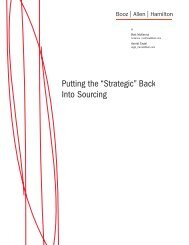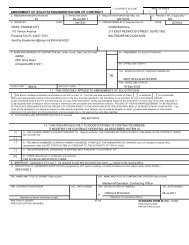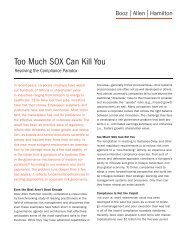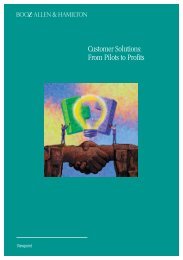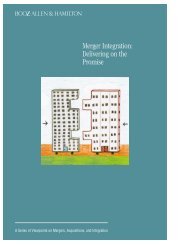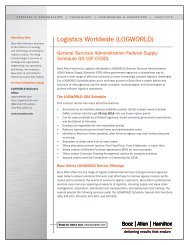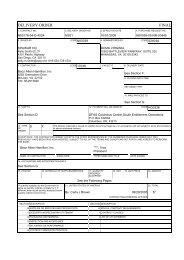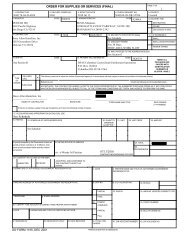Building the Enterprise - Booz Allen Hamilton
Building the Enterprise - Booz Allen Hamilton
Building the Enterprise - Booz Allen Hamilton
- No tags were found...
You also want an ePaper? Increase the reach of your titles
YUMPU automatically turns print PDFs into web optimized ePapers that Google loves.
PREFACEWhen we launched this project one year ago, ourgoal was to define and articulate a set of reformsthat would help guide <strong>the</strong> presidentialmanagement agenda. We started by interviewing someof <strong>the</strong> smartest public management experts we know—seasoned practitioners and policy makers who have conceivedand implemented government reforms, scholarswho have studied and documented reform efforts foryears, and executives who are driving management innovationin <strong>the</strong> public and private sectors.It was immediately obvious that <strong>the</strong> task was goingto be complicated. Many good ideas were tested during<strong>the</strong> past two decades by <strong>the</strong> Clinton and Bush administrations.The Obama administration abandoned some andadopted o<strong>the</strong>rs in whole or part, and in July 2013 recommittedto streng<strong>the</strong>ning three pillars of its managementagenda—improved service delivery, reducing waste andsaving money, and increasing <strong>the</strong> transparency of governmentdata.While our experts offered a wide range of differingproposals for improving government operations, consensusemerged around two basic <strong>the</strong>mes: one, that fiscal constraintsprovide both incentive and opportunity to findsmarter ways of doing <strong>the</strong> people’s business; two, that <strong>the</strong>problems our nation faces—from national security to <strong>the</strong>economy to health care—are growing increasingly complexand cannot be solved by any individual agency. Mostchallenges today require <strong>the</strong> collective action of severalagencies and, in many instances, <strong>the</strong> engagement of local,state and international partners in <strong>the</strong> public and privatesectors. The problem is that our government is not set upto easily achieve such unity of effort and often has multipleagencies and programs acting separately to achieve<strong>the</strong> same or similar outcomes—a hindrance for both <strong>the</strong>employees who must perform government missions andfunctions, as well as for those who depend on <strong>the</strong>m.So <strong>the</strong> recommendations in this report focus on acentral premise: Our government must take a more coordinated,multiagency, whole-of-government approach—in o<strong>the</strong>r words, an enterprise approach—to <strong>the</strong> nation’smost difficult and enduring challenges.In times of crisis, Americans are very good at rallyingaround a desired outcome once it has been clearlydefined. Defeat <strong>the</strong> Nazis. Make sure war-torn Japan andEurope survive as democratic societies. Win <strong>the</strong> race to<strong>the</strong> moon. Take care of <strong>the</strong> elderly. Clean <strong>the</strong> polluted airand water. Fight terrorism. Crises focus us and unify ourgovernment. Agencies collaborate and act as one. Government’sresources are marshaled and applied. But in <strong>the</strong>absence of obvious, pressing crises, this unity of purposeand action is <strong>the</strong> exception ra<strong>the</strong>r than <strong>the</strong> rule. Given<strong>the</strong> nature of <strong>the</strong> challenges that our government and nationface, that must change. Our bottom line is that governmentmust approach its work as an enterprise everyday to tackle today’s critical challenges. Spur economicgrowth. Reduce joblessness. Fix education. Safeguardfood. Halt nuclear proliferation. Secure cyberspace.By taking a multiagency enterprise approach to thosechallenges, we can build on <strong>the</strong> progress of <strong>the</strong> past twodecades, improve <strong>the</strong> overall performance of <strong>the</strong> federalgovernment and, in so doing, restore <strong>the</strong> American public’strust and confidence in it.The outcome we seek is a federal government thatacts as a single, integrated enterprise—not a set of disconnectedagencies and programs—in taking on its biggestproblems.Max StierPresident and CEOPartnership for Public ServiceLloyd W. Howell Jr.Executive Vice President<strong>Booz</strong> <strong>Allen</strong> <strong>Hamilton</strong>BUILDING THE ENTERPRISE 1





